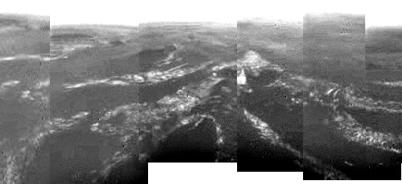Composite of Titan’s Surface Seen During Descent

| PIA Number | PIA07230 |
|---|---|
| Language |
|
This composite was produced from images returned yesterday, January 14, 2005, by the European Space Agency's Huygens probe during its successful descent to land on Titan. It shows a full 360-degree view around Huygens. The left-hand side, behind Huygens, shows a boundary between light and dark areas. The white streaks seen near this boundary could be ground 'fog,' as they were not immediately visible from higher altitudes.
As the probe descended, it drifted over a plateau (center of image) and was heading towards its landing site in a dark area (right). From the drift of the probe, the wind speed has been estimated at around 6-7 kilometers (about 4 miles) per hour.
These images were taken from an altitude of about 8 kilometers ( about 5 miles) with a
resolution of about 20 meters (about 65 feet) per pixel. The images were taken by the Descent Imager/Spectral Radiometer, one of two NASA instruments on the probe.
The Cassini-Huygens mission is a cooperative project of NASA, the European Space Agency and the Italian Space Agency. The Jet Propulsion Laboratory, a division of the California Institute of Technology in Pasadena, manages the Cassini-Huygens mission for NASA's Science Mission Directorate, Washington, D.C. The Cassini orbiter and its two onboard cameras were designed, developed and assembled at JPL. The Descent Imager/Spectral team is based at the University of Arizona, Tucson, Ariz.
For more information about the Cassini-Huygens mission visit http://saturn.jpl.nasa.gov/home/index.cfm .
Credit: ESA/NASA/Univ. of Arizona
